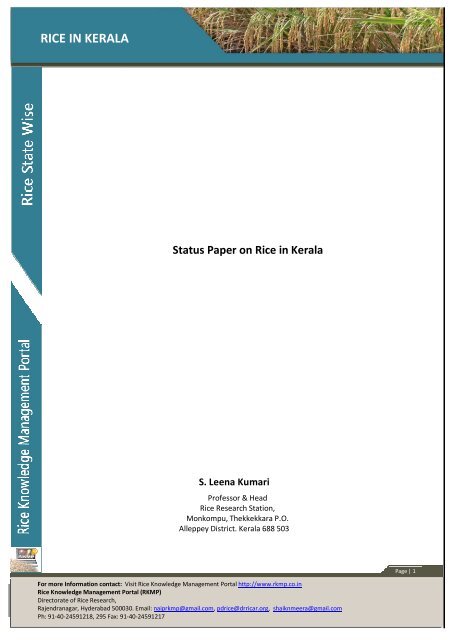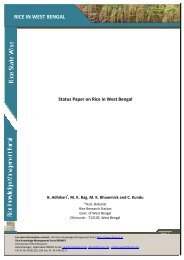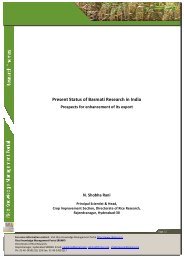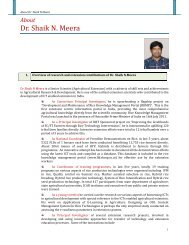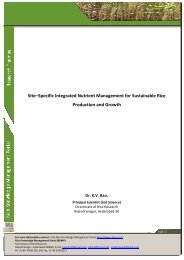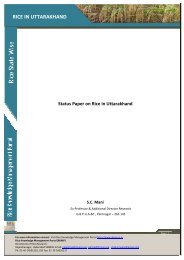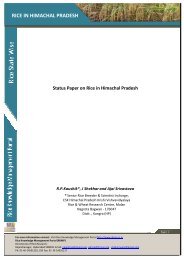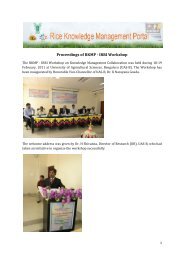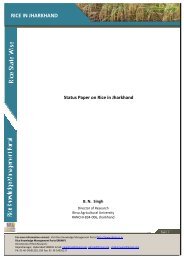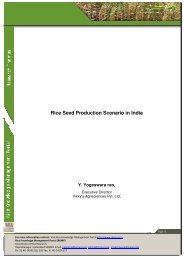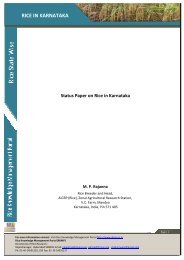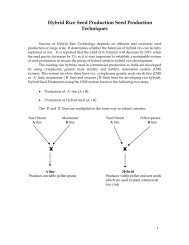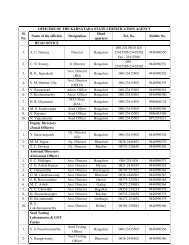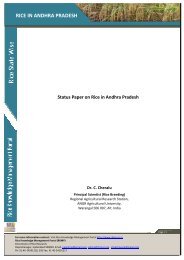RICE IN KERALA - Rice Knowledge Management Portal
RICE IN KERALA - Rice Knowledge Management Portal
RICE IN KERALA - Rice Knowledge Management Portal
- No tags were found...
You also want an ePaper? Increase the reach of your titles
YUMPU automatically turns print PDFs into web optimized ePapers that Google loves.
<strong>RICE</strong> <strong>IN</strong> <strong>KERALA</strong>2006-07 over the ,last two years mainly due to the concerted effort of the Government At present , riceis grown in a gross area of 2.34 lakh ha producing 6.25 lakh tonnes with a productivity of 2671 kg.VII.<strong>Rice</strong> and rice based cropping systems – zone-wiseSl. No. Zones Cropping patterns1 Onattukara <strong>Rice</strong>- <strong>Rice</strong>- Legumes/ <strong>Rice</strong>- <strong>Rice</strong> – Sesame/ <strong>Rice</strong> – <strong>Rice</strong>-Vegetables, Rie- <strong>Rice</strong>- fallow2 Coastal Sandy <strong>Rice</strong> – Prawn/ <strong>Rice</strong>- fallow3 Southern Midlands <strong>Rice</strong>- <strong>Rice</strong>- fallow/ <strong>Rice</strong> – <strong>Rice</strong>- Vegetables, Fallow-<strong>Rice</strong> – fallow4 Central Midlands <strong>Rice</strong>- <strong>Rice</strong>- fallow/ <strong>Rice</strong> – <strong>Rice</strong>- Vegetables5 Northern Midlands <strong>Rice</strong>- <strong>Rice</strong>- fallow/ <strong>Rice</strong> – <strong>Rice</strong>- Vegetables6 Malappuram Type <strong>Rice</strong> – <strong>Rice</strong>- Vegetables7 Malayorum <strong>Rice</strong> – <strong>Rice</strong>- Vegetables8 Palakkadu plains <strong>Rice</strong>- <strong>Rice</strong>- fallow/ <strong>Rice</strong> – <strong>Rice</strong>- Vegetables9 Red loam <strong>Rice</strong>- <strong>Rice</strong>- fallow/ <strong>Rice</strong> – <strong>Rice</strong>- Vegetables10 Chittoor black soil <strong>Rice</strong>- <strong>Rice</strong>- Legumes11 Kuttanadu <strong>Rice</strong>- <strong>Rice</strong>- water fallow <strong>Rice</strong>- Fish12 Riverbank alluvium <strong>Rice</strong>- <strong>Rice</strong>- fallow/ <strong>Rice</strong> – <strong>Rice</strong>- Vegetables13 High ranges <strong>Rice</strong>- <strong>Rice</strong>- fallow/ <strong>Rice</strong> – <strong>Rice</strong>- VegetablesVIII. <strong>Rice</strong> growing seasons and regionsThere are three main rice-growing seasons in Kerala. They are: (a) Virippu season/ Autumnseason/ First crop season which starts in April-May and extends up to September-October, (b) Mundakanseason/ Winter season/ Second crop season which starts in September-October and extends up toDecember- January, and (c) Puncha season / Summer season/Third crop season which starts inDecember-January and extends up to March-April.For more Information contact: Visit <strong>Rice</strong> <strong>Knowledge</strong> <strong>Management</strong> <strong>Portal</strong> http://www.rkmp.co.in<strong>Rice</strong> <strong>Knowledge</strong> <strong>Management</strong> <strong>Portal</strong> (RKMP)Directorate of <strong>Rice</strong> Research,Rajendranagar, Hyderabad 500030. Email: naiprkmp@gmail.com, pdrice@drricar.org, shaiknmeera@gmail.comPh: 91-40-24591218, 295 Fax: 91-40-24591217Page | 8
<strong>RICE</strong> <strong>IN</strong> <strong>KERALA</strong>Koottu-mundakanVirippu+MundakanSwarnaprabha+ Makaram, Swarnaprabha+ KumbhamKarthika+ Makaram, Karthika+KumbhamScented rice Nanja Pusa basmati 1, Pusa SugandhMundakanPusa basmati 1, Pusa SugandhDeep ill-drainedregions ofsouthern districtsFirst cropRemya, ArathySecond cropMakaram, Kumbham, Dhanu, Thulaam, MangalamahsuriWaterlogged andflooded areasFirst cropIR-5, Pankaj, Jagannath, H4, Mahsuri, Neeraja, Mangalamahsuri,Ezhome-2OorumundakanSecond cropSagaraEarly duration: Annapurna, Mattatriveni, Jyothy, Bhagya, Rohini, Onam,Onattukaracoastal sandyareasandFirst cropChingam, Aruna, Makom, Karthika, Revathy, Remanika, Krishnanjana,PrathyaasaMedium duration: Jaya, Sabari, Bharathy, Aswathy, Pavizham, Remya,Kanakom, Arathy, Renjini, Pavithra, Panchami, Uma, Gouri.Second cropEarly Duration: Annapurna, Mattatriveni, Makom, Jyothy, Karthika,Revathy, Remanika, KrishnanjanaPage | 12For more Information contact: Visit <strong>Rice</strong> <strong>Knowledge</strong> <strong>Management</strong> <strong>Portal</strong> http://www.rkmp.co.in<strong>Rice</strong> <strong>Knowledge</strong> <strong>Management</strong> <strong>Portal</strong> (RKMP)Directorate of <strong>Rice</strong> Research,Rajendranagar, Hyderabad 500030. Email: naiprkmp@gmail.com, pdrice@drricar.org, shaiknmeera@gmail.comPh: 91-40-24591218, 295 Fax: 91-40-24591217
<strong>RICE</strong> <strong>IN</strong> <strong>KERALA</strong>Medium duration: Jaya, Sabari, Bharathy, Aswathi, Pavizham, Remya,Kanakom, Dhanya (season bound), Renjini, Pavithra, Panchami, Uma,Gouri.Annapurna, Mattatriveni, Rohini, Makom, Revathi, Remanika,Third cropKrishnanjana.Medium duration: Jaya, Sabari, Bharathy, Aswathy, Pavizham, Remya,Kanakom, Renjini, Pavithra, Panchami, Uma, Gouri.Poonthalpadam( Paalakkad)Neeraja, Ponmani,PranavaHigh altitude area:a. Single cropJaya, Sabari, Mahsuri, Bhadra, IR 8, Aathira, Umaareasb. Double cropareasFirst crop Aswathy, Jaya, Sabari, Bharathy. Bhadra, Deepthi, Aathira, IR 8Second crop Aswathy, Jaya, Sabari, Bharathy, Bhadra, Deepthi, Aathira, IR 8c. Eastern lateriticregions of Kollam& AlappuzhadistrictsSecond cropMakaram, Kumbham, Dhanu, ThulaamChitoor black soil First crop ASD 16, ASD 17, Mahsuri, Varsha, ADT 43, UmaSecond cropPonni, Vellaponni, Ponmani, ASD 16, ASD 17, Pranava, Swetha, Bhadra,Renjini.Source: KAU 2007Page | 13For more Information contact: Visit <strong>Rice</strong> <strong>Knowledge</strong> <strong>Management</strong> <strong>Portal</strong> http://www.rkmp.co.in<strong>Rice</strong> <strong>Knowledge</strong> <strong>Management</strong> <strong>Portal</strong> (RKMP)Directorate of <strong>Rice</strong> Research,Rajendranagar, Hyderabad 500030. Email: naiprkmp@gmail.com, pdrice@drricar.org, shaiknmeera@gmail.comPh: 91-40-24591218, 295 Fax: 91-40-24591217
<strong>RICE</strong> <strong>IN</strong> <strong>KERALA</strong>b. Most popular rice varieties / hybrids of the stateThe most populr rice variety of the State is Uma ( MO.16) developed by <strong>Rice</strong> Research Station,Moncompu followed by Jyothi, developed from Regional Agricultural Research Station, Pattambi. Theother varieties popular in the State in the order of their preference are Aiswarya, Kanchana, Aathira,Matta Triveni, Harsha, Vaisagh, Bhadra, Krishnanjana, Makom, Gouri etc.X. Traditional cultivars varieties grown if any, in the state.a. Germplasm ResourcesTaking into consideration the variation in resource endowments, topography, soil, abiotic factors andseasonal differences, rice grown in the state are grouped under eight different agro eco systems. Thenatural and artificial selections operating in these areas over long periods of time have resulted in a largenumber of traditional varieties suited to each region and possessing special traits like resistance to bioticand abiotic stresses, ability to survive extreme agro-edaphic situations, quality attributes like medicinalvalue, aroma and suitability to special purposes which constitute an invaluable reservoir of genes thatare used by plant breeders for development of superior crop varieties.The local land races grown in different agro climatic regions of Kerala differ for a range of charactersincluding crop duration, plant height, tillering, pigmentation of various plant parts, panicle characters,grain characters as well as grain and straw production. There are photo insensitive varieties andphotosensitive varieties maturing in 60-260 days. Tremendous variation exists for grain characters viz.,grain color, grain shape , grain size, kernel color, aroma, puffing, popping, flattening, cooking and eatingqualities. The latter reflect varietal preferences for different traditional food preparations.. Grain coloritself varies from straw to gold to brown tinges to complete brown and to black . The grain size variesfrom round to short bold to long bold to long slender with long bold red kernelled grains being mostlypreferred by the local farmers. It is supposed that near about two thousand traditional varieties whichwere well suited for different agro climatic situations and seasons of rice cultivation were predominantlycultivated in Kerala. They include varieties possessing resistant genes against biotic and abiotic stresses,rice varieties which were locally used as medicine or as ingredients in medical preparations, and scentedrice varieties which differ from the scented "Basmathi" rice with respect to growth habits as well asphysico-chemical properties of the grains .For more Information contact: Visit <strong>Rice</strong> <strong>Knowledge</strong> <strong>Management</strong> <strong>Portal</strong> http://www.rkmp.co.in<strong>Rice</strong> <strong>Knowledge</strong> <strong>Management</strong> <strong>Portal</strong> (RKMP)Directorate of <strong>Rice</strong> Research,Rajendranagar, Hyderabad 500030. Email: naiprkmp@gmail.com, pdrice@drricar.org, shaiknmeera@gmail.comPh: 91-40-24591218, 295 Fax: 91-40-24591217Page | 14
<strong>RICE</strong> <strong>IN</strong> <strong>KERALA</strong>c. Medicinal valueThough the bulk of the wide variability in medicinal rices grown in Kerala are lost, some ricevarieties are still grown by farmers for their medicinal properties, which include Njavara, Chennellu,Kunjinellu, Erumakkari, Karuthachembavu and Kavunginpoothala (Leena Kumary, 2004). The medicinalproperty of these rice varieties have to be validated by clinical studies, but traditional knowledgeassociated with these varieties substantiate their use either as medicine or as ingredient in medicinalpreparations. Njavara, is the unique medicinal rice variety from Kerala deserves special mention in thisregard. This variety is known as "Shashtikam" in Sanskrit due to its extra short duration, coming toharvest within 60-70 days. Indigenous medicinal preparation using Njavara along with Kurunthotti("Sida") rejuvenates the muscles and nerves. Two types of Njavara have been identified, the whiteglumed and black glumed, both of which are used in Ayurvedic treatments. Chennellu and Kunjinelluare varieties indigenous to North Kerala. One type of Chennellu with bright red grains, grown as anupland variety in parts of Kannur district is used in treatment of diarrhoea and vomiting. Another type ofChennellu with straw coloured grains is grown in wet lands in Wayanad district. Kunjinellu is a variant ofred coloured Chennellu, with small red grains and is given to patients recovering from jaundice.Erumakkari and Karuthachembavu are the traditional rice varieties indigenous to South Kerala.Karuthachambavu has black grains, blackish red kernels and black endosperm. The gruel made by thepoached grains of Karuthachambavu is used to treat nausea, vomiting and stomach pains. Erumakkariwas used for treatment of cough. Annoori, a wild species of rice is used by the kani tribes for treatmentof small pox. Kavunginpoothala indigenous to Palakkad District is given to diabetic patients to reducediscomfort (Leena Kumary,.2004)XI.Indigenous technical knowledge (ITKs) specific to the stateKerala is well known for the rich genetic diversity of the traditional rice varieties grown in variousseasons and in different agro-climatic conditions which includes many medicinal rices also. Theindigenous medicinal rices are used either as medicine or as ingredients in medicinal preparations on alimited scle The traditional knowledge associated with the medicinal rices are tabulated below.For more Information contact: Visit <strong>Rice</strong> <strong>Knowledge</strong> <strong>Management</strong> <strong>Portal</strong> http://www.rkmp.co.in<strong>Rice</strong> <strong>Knowledge</strong> <strong>Management</strong> <strong>Portal</strong> (RKMP)Directorate of <strong>Rice</strong> Research,Rajendranagar, Hyderabad 500030. Email: naiprkmp@gmail.com, pdrice@drricar.org, shaiknmeera@gmail.comPh: 91-40-24591218, 295 Fax: 91-40-24591217Page | 15
<strong>RICE</strong> <strong>IN</strong> <strong>KERALA</strong>Sl.No.VarietyTraditional use as medicine1 Njavara The grains are sweet, acrid, oleaginous, aphrodisiac, diuretic,carminative, anti-dysenteric and tonicThe roots of this rice are said to be cooling, diuretic and febrifuge andare useful in burning sensation, dyspepsia, bilious fever and diabetes.Regular consumption of Njavara rice gruel cooked in cow’s milk ensureslongevity and increase milk flow in lactating mothers.Njavara rice is recommended for acute complaints of piles and fordiabetic patients.Considered as a safe food for snake-bitten patients and people withstomach ulcer.Application of Njavara rice paste is found effective for swelling in foot,reduces pain of snake bitesUsed as a healthy baby food2 Chennellu Used in treatment of diarrhoea and vomiting.For more Information contact: Visit <strong>Rice</strong> <strong>Knowledge</strong> <strong>Management</strong> <strong>Portal</strong> http://www.rkmp.co.in<strong>Rice</strong> <strong>Knowledge</strong> <strong>Management</strong> <strong>Portal</strong> (RKMP)Directorate of <strong>Rice</strong> Research,Rajendranagar, Hyderabad 500030. Email: naiprkmp@gmail.com, pdrice@drricar.org, shaiknmeera@gmail.comPh: 91-40-24591218, 295 Fax: 91-40-24591217Page | 16
<strong>RICE</strong> <strong>IN</strong> <strong>KERALA</strong>3 Kunjinellu Given to patients recovering from jaundice.4 Erumakkari Used for treatment of cough in humans and also for some diseases ofcattle5 Karuthachambavu The gruel made by the poached grains is used to treat nausea, vomitingand stomach pains.6 Kavunginpoothala Recommended for diabetic patients7 Varinellu Used by the tribal folk for treatment of small poxNjavara, the unique medicinal rice of Kerala is put to a number of clinical uses also, whichis well documented in the ancient ayurvedic literature, and a few of them are mentioned below. Njavararice is used in Ayurveda for treatment of paralytic conditions and muscle wasting. It increases the growthof muscles and stimulates the nerve endings. Ashtangahridayakara advises every one to take Njavara riceduring the time of pathyacharana (observing strict time-schedule and keeping special rules and regimennormally after undergoing ayurvedic treatments, especially the Panchakarma). This has a wide range ofbenefits including aphrodisiac. The oil prepared out of Njavara rice is used for a wide range of aches andpainful conditions like the cervical spondylosis, low back ache, paralysis, rheumatoid arthritis (in somestages) etc.The most important use of Njavara is in Njavarakizhi in which Njavara rice is the base. Oleation tohead and body using special cloth pieces containing a smooth paste of Njavara rice cooked in Sida ( Sidarectusa. Lin) decoction and milk, makes the body supple, removes stiffness of joints due to variousvitiated Vatha dominant conditions, cleans the body channels, and brings about better blood circulation.It improves complexion, increases appetite, improves digestion, restores relish for food, and corrects themental irregularities. This makes the body strong and steady, rejuvenated with well-developedmusculature. Judicious application of this is very effective in hypertension, skin diseases and preventspremature ageing.For more Information contact: Visit <strong>Rice</strong> <strong>Knowledge</strong> <strong>Management</strong> <strong>Portal</strong> http://www.rkmp.co.in<strong>Rice</strong> <strong>Knowledge</strong> <strong>Management</strong> <strong>Portal</strong> (RKMP)Directorate of <strong>Rice</strong> Research,Rajendranagar, Hyderabad 500030. Email: naiprkmp@gmail.com, pdrice@drricar.org, shaiknmeera@gmail.comPh: 91-40-24591218, 295 Fax: 91-40-24591217Page | 17
<strong>RICE</strong> <strong>IN</strong> <strong>KERALA</strong>XII. Institutes involved in rice development in the state and their contributionThe Kerala Agricultural University (KAU) was established in 1972 and the agricultural researchinstitutions that were administered by the Departments of Agriculture and Animal Husbandry until thenwere transferred the KAU in 1972. Since then, the agricultural research organization has beenrestructured for accelerated development of agriculture in the State. In 1981, under the NationalAgricultural Research Project ( NARP), the rice research activities were again re oriented to conductlocation specific production oriented research based on agro-climatic regions. Accordingly, five RegionalAgricultural Research Stations for the North, South and Central, High range and Special zones startedfunctioning. At present, rice research is being conducted at the following research stations to cater theneeds of the different zones (KAU,1989)• Regional Agricultural Research Station, Pattambi in Plalakkad district for the development oflaterite midlands. Here research is going on for the Palakkattu plains and black soil zone ofChittoor taluk in the eastern region of Palakkad District also• Regional Agricultural Research Station, Kayamkulam in Alappuzha district. The lead function ofthe station is to conduct research on rice and rice based farming system for the Onattukararegion. Here research is going on in paddy, pulses and oil seeds.• <strong>Rice</strong> Research Station at Moncompu in Alleppey district for Kuttanad zone to conduct research onall aspects of rice cultivation in the submerged Kayal and semi dry Karappadom lands ofKuttanadu agro eco system.• Agricultural Regional Agricultural Research Station, Ambalavayal in Wayanad district to cater tothe needs of high range zone.• Research Station at Mannuthy in Thrissur district to cater to the needs of the Kole region• <strong>Rice</strong> Research Station at Vytilla in Ernakulam district for the development of Pokkali zone.Contribution of the Institutes towards rice farming in Kerala :Varieties developed throughimprovement of local varieties.The earlier attempts for rice improvement before the advent of green revolution were largelyconcentrated on improving the local varieties through selection. Thirty five rice varieties with the prefix‘PTB’ were released from Pattambi, three ‘MO’ varieties from Moncompu , three ‘VTL’ varieties fromVytilla , four from Kayamkulam ( two KYLM and two KTR varieties) and two from Ambalawayal ( WND)have all been developed either through mass selection or pure line selection of traditional varieties whichFor more Information contact: Visit <strong>Rice</strong> <strong>Knowledge</strong> <strong>Management</strong> <strong>Portal</strong> http://www.rkmp.co.in<strong>Rice</strong> <strong>Knowledge</strong> <strong>Management</strong> <strong>Portal</strong> (RKMP)Directorate of <strong>Rice</strong> Research,Rajendranagar, Hyderabad 500030. Email: naiprkmp@gmail.com, pdrice@drricar.org, shaiknmeera@gmail.comPh: 91-40-24591218, 295 Fax: 91-40-24591217Page | 18
<strong>RICE</strong> <strong>IN</strong> <strong>KERALA</strong>High yielding rice varietiesWith the advent of 'Green Revolution', efforts to develop high yielding, dwarf, fertilizerresponsive varieties of rice suitable for Kerala was started at Pattambi. Hybridisation work was taken upbetween the traditional varieties of the state and high yielding varieties like DGWG, IR 8, T (N) 1 etc totransfer the dwarf genes to traditional varieties. The first hybrid derivative, Annapoorna (PTB35), thefirst high yielding, early, dwarf rice for South East Asia was released in India in 1966, the same year inwhich IRRI released the variety IR 8. This was widely adopted with the known management practices forraising high yielding varieties with respect to the fertilizer application, use of pesticides etc. This broughtabout a great revolution in total rice production scenario of the state with an average yield of nearly5t/ha. This was followed by a series of varieties like Rohini, Aswathy, Triveni, Jyothi, Bharathy, Sabari andSuvarnamodan. The rice variety Jyothi released in 1974 still continues to be the prominent variety inKerala due its good cooking quality and is also grown in other States like Karnataka, Andhra Pradesh etc.The variety Rohini has a high protein content ( > 12%) and is considered good for diabetic patients.Efforts to develop desirable mutants of the traditional tall indicas of Kerala were initiated in theKerala Agricultural University during early seventies. The traditional tall varieties were subjected toirradiation at varying doses to change the plant type without disturbing other important characters vizadaptability to varying agro-ecological conditions, resistance / tolerance to biotic and abiotic stresses andred kernel colour. An awnless, early maturing (10-15 days early) mutant was isolated in the M 2generation of the gamma (γ) ray treated population of Oorpandy, the long awned saline resistant localvariety of Ernakulam district in Kerala. Based on the performance of this line in station trials and farmtrials, it was released as Rasmi in 1985. The variety is resistant to gall midge, BPH and blast and is used asa donor for multiple resistance in the rice breeding programmes at the national level. Dwarf mutants ofMO1, a selection from Chettivirippu, the tall indica variety of the coastal region of Kerala, obtained in theM 5 generation were tested for yield in the research stations under the Kerala Agricultural University. Themost efficient mutant among these viz ., Cul. MO. I. 20- 19- 4, which had profuse tillers and high grainyield was released for general cultivation as Remanika in 1998. It exhibits high resistance to BPH andmoderate resistance to diseases like sheath blight, sheath rot and pests like gall midge, the major bioticstresses for rice in KeralaFor more Information contact: Visit <strong>Rice</strong> <strong>Knowledge</strong> <strong>Management</strong> <strong>Portal</strong> http://www.rkmp.co.in<strong>Rice</strong> <strong>Knowledge</strong> <strong>Management</strong> <strong>Portal</strong> (RKMP)Directorate of <strong>Rice</strong> Research,Rajendranagar, Hyderabad 500030. Email: naiprkmp@gmail.com, pdrice@drricar.org, shaiknmeera@gmail.comPh: 91-40-24591218, 295 Fax: 91-40-24591217Page | 20
<strong>RICE</strong> <strong>IN</strong> <strong>KERALA</strong>Panchami in 1998 could combat the problem of Gall midge to a great extent in Kuttanad. Another majorproblem of rice cultivation in Kuttanad viz., Blast disease was brought under control with thedevelopment of Renjini with blast resistance which was also released from RRS Moncompu. During2002, another rice variety ‘Gouri’ which is moderately resistant to sheath blight was released from <strong>Rice</strong>Research Station, Moncompu, followed by Prathyasa, a short duration rice variety for the double croppedwet lands of Kuttanad during 2009.<strong>Rice</strong> varieties resistant to abiotic stressesProgrammes to evolve varieties with resistance or tolerance to abiotic stresses viz., flood, cold,drought, salinity, soil problems like acidity, alkalinity and sulphide injury etc. were also under-taken bythe Kerala Agricultural University. Breeding for Flood tolerance has resulted in the identification andrelease of one flood tolerant high yielding variety BR 51-315-4 christened Neeraja in 1992 from RARS,Pattambi and two varieties from <strong>Rice</strong> Research Station, Kayamkulam viz, Makaram & Kumbham whichare photosensitive long duration varieties, evolved through pure line selection from the local cultivar“Cheradi”. Two dwarf, white riced cultures, viz., Cul 745 and Cul 796 with 160-165 days duration givinggood germination under low temperature were identified at RARS, Pattambi .<strong>Rice</strong> varieties for the Khariff season of Palakkad and Onattukara in Kerala needed droughtresistance since the seeds are dry sown with the receipt of pre monsoon showers and the seedlingssuffer water scarcity for almost a month before regular monsoon starts. Breeding work at RARS, Pattambiand Onattukara Regional Agricultural Research Station, Kayamkulam has identified two rice varieties‘Harsha’ for Palakkad and ‘Chingam’ for Onattukara respectively.Breeding programmes for salinity resistance is carried out at mainly at Vytilla and some initialworks were carried out at RARS, Pattambi and RRS, Kayamkulam also. From RRS, Vytilla, eight ricevarieties viz., Vytilla 1 to Vytilla 8 with resistance to salinity have been released so far. From <strong>Rice</strong>Research Station, Kayamkulam, one variety “Sagara” which is a Pure line selection from the traditionalvariety Orumundakan was released for cultivation in the saline areas of Karthikappally taluk of Kerala.Soil problems like acidity, alkalinity and sulphide injury were limiting rice production in the ‘Kari’areas of Kerala viz., Karumady, Purakkad etc. and breeding works were initiated at RRS, Moncompuduring 1984 to develop rice varieties which can tolerate such soil problems. Two rice varieties viz.,For more Information contact: Visit <strong>Rice</strong> <strong>Knowledge</strong> <strong>Management</strong> <strong>Portal</strong> http://www.rkmp.co.in<strong>Rice</strong> <strong>Knowledge</strong> <strong>Management</strong> <strong>Portal</strong> (RKMP)Directorate of <strong>Rice</strong> Research,Rajendranagar, Hyderabad 500030. Email: naiprkmp@gmail.com, pdrice@drricar.org, shaiknmeera@gmail.comPh: 91-40-24591218, 295 Fax: 91-40-24591217Page | 22
<strong>RICE</strong> <strong>IN</strong> <strong>KERALA</strong>Karishma and Krihnanjana were released during 1998 which can tolerate acidity and sulphide injury andcan give moderate levels of yield to farmers.XIIIConstraints in rice productiona. Biotic stress - Insects, Diseases, Nematodes, rodents, and weeds.Kerala is a hot spot for pests and diseases. The high humidity and temperature of the ricegrowing environments during the cropping periods increases the incidence of pests anddiseases. Major insect pests include BPH, Stem borer, Gall midge, leaf roller and rice bug andminor pests include thrips, case worm, blue beetle, whorl maggot etc. The minor pests areslowly emerging as major pests threatening rice cultivation in the State.Fungal diseases like Blast, Sheath blight, Sheath rot, Brown spot, False smut, Leaf scald and graindiscoloration, Bacterial diseases like bacterial leaf blight, and viral diseases like <strong>Rice</strong> TungroVirus, Grassy Stunt Virus etc. cause severe damage to rice crop in Kerala.Rodents cause almost 25-30 % crop loss in rice in Kuttanad. The major spp. found in Kuttanad rice fieldsare Bandicota bengalensis, Tatera indica, and Bandicota indica .The major weeds of Kerala are Alternanthera, Aeschynomene , Cleome sp., Cyperus sp.,Echinochloa sp.(Echinochloa colona, Echinochloa crusgalli and Echinochloa glabrascence),Eichornea, Fimbristylis miliaceae, Grangea maderaspatana ,Hydrolea, Monochoria, , Lindernia,Ludwigia parviflora, Oldenlandia, Phyllanthus, Salvinia, Sphaeranthus indicus ,Sphenocleazeylanica, Wild rice etc. Of this, Cyperus sp. is the most abundant weed sp. present in all therice growing tracts of Kerala and Grangea maderaspatana is observed mainly in the kole lands ofKerala .For more Information contact: Visit <strong>Rice</strong> <strong>Knowledge</strong> <strong>Management</strong> <strong>Portal</strong> http://www.rkmp.co.in<strong>Rice</strong> <strong>Knowledge</strong> <strong>Management</strong> <strong>Portal</strong> (RKMP)Directorate of <strong>Rice</strong> Research,Rajendranagar, Hyderabad 500030. Email: naiprkmp@gmail.com, pdrice@drricar.org, shaiknmeera@gmail.comPh: 91-40-24591218, 295 Fax: 91-40-24591217Page | 23
<strong>RICE</strong> <strong>IN</strong> <strong>KERALA</strong>b. Abiotic stress – Temperature, cold, drought, water logging, sodic, saline problems.SalinityKerala with its long coastal line of about 580 km has several lagoons or backwaters covering avery large area linked to the sea. In most of the coastal land, deltaic areas at river mouths andreclaimed backwaters are either at sea level or 1.0 to 1.5 m below MSL. This leads to intrusion ofsea water upto a distance of 10 to 20 km upstream during high tides. These periodically salinewater inundated lands constitute the major saline soil areas of the State covering an area of30,000 ha.Zinc and Copper deficiencyZinc deficiency is noticed in 30% of Kuttanad area (approx. 9000 ha). Copper deficiency isnoticed in 21% of the Kuttanad area ( approx 6300 ha).Calcium and Magnesium deficiencyCalcium deficiency is noticed in 30 % of Kuttanad area (approx. 9000 ha). Magnesium deficiencyis noticed in 16 % of Kuttanad area (approx. 4800 ha).ColdIn High ranges, cold stress is experienced in Winter which coincides with the Punja crop.DroughtIn Palakkad and Onattukara ecosystems, drought is a stress limiting rice production in Kharifseason. Drought is also experienced during the fag end of Rabi season in Eastern Palakkad,where maximum area is under irrigation and water shortage is experienced during summermonths.For more Information contact: Visit <strong>Rice</strong> <strong>Knowledge</strong> <strong>Management</strong> <strong>Portal</strong> http://www.rkmp.co.in<strong>Rice</strong> <strong>Knowledge</strong> <strong>Management</strong> <strong>Portal</strong> (RKMP)Directorate of <strong>Rice</strong> Research,Rajendranagar, Hyderabad 500030. Email: naiprkmp@gmail.com, pdrice@drricar.org, shaiknmeera@gmail.comPh: 91-40-24591218, 295 Fax: 91-40-24591217Page | 24
<strong>RICE</strong> <strong>IN</strong> <strong>KERALA</strong>Flash floods and saline water intrusion in the coastal areas and Kuttanad, drought in Palakkad andOnattukara, and soil problems including acidity, iron toxicity, sulphide injury etc. in the Kari soils are themajor abiotic stresses limiting rice production in the stateEconomics of rice production in the state<strong>Rice</strong> is a socially and politically important crop of Kerala. The wet humid tropical climate of Kerala isconducive to the cultivation of rice and traditionally rice occupied a prime position in Kerala’s agricultureHowever, area under rice has been declining over the years, with a possibility of extinction of rice farmingin the state. The livelihood security of the rural agrarian population revolving around rice farming is indanger. The employment opportunities in this sector, especially for women are declining at a rapid rate.It has become important to sustain and promote rice cultivation by promoting the multiple livelihoodopportunities linked with rice farming, among the socially and economically disadvantaged groups.Escalating cost of production is weaning away rice farmers from cultivation. <strong>Rice</strong> being a labourintensive crop, apprehensions of agricultural labourers on area conversion are also not unfounded. Theplight of an estimated 50 lakh bovine population of the state can be at stake since paddy straw is theironly source of sustenance. Environmental and ecological implications of large scale area conversion fromrice can be disturbing. For example, in 1975, Kerala’s rice production of 13.5 lakh tons was over 50 percent of her consumption requirement. By 2010 the consumption production gap has increased to 84 percent. As rice remains the staple food, food security of the state is at stake and dependency on otherStates for our staple food is increasing dangerously. Employment prospects of agricultural labourers arebecoming bleak.The requirement of human labour for rice cultivation is very high in Kerala ie., around 148 man daysconstituting more than 70% of the total cost. A study on the decennial changes in the structure of costof cultivation per ha. of rice in Kuttanad showed that between 1988 and 1998, share of expenditure onhuman labour increased substantially from 42 per cent to 61 per cent and has still increased during 2003-04. A census on agricultural labourers shows marginal increase, but the fact is that the number oflabourers is also dwindling. There have been reports thataverage age of women agricultural labourforce in the rice bowls of the state is above 60. This has eroded the efficiency of labour.The average cost of rice production is highest in Kerala when compared o other States.As per the latest report of the Commission on Agricultural Costs and Prices. Government ofFor more Information contact: Visit <strong>Rice</strong> <strong>Knowledge</strong> <strong>Management</strong> <strong>Portal</strong> http://www.rkmp.co.in<strong>Rice</strong> <strong>Knowledge</strong> <strong>Management</strong> <strong>Portal</strong> (RKMP)Directorate of <strong>Rice</strong> Research,Rajendranagar, Hyderabad 500030. Email: naiprkmp@gmail.com, pdrice@drricar.org, shaiknmeera@gmail.comPh: 91-40-24591218, 295 Fax: 91-40-24591217Page | 25
<strong>RICE</strong> <strong>IN</strong> <strong>KERALA</strong>6. Production, multiplication and distribution of quality seed to ensure supply of right seedsin the right quantity at the right time.7. Integrated Pest <strong>Management</strong>8. Encouraging farm mechanization9. Minimising Post harvest loss10. Strengthening the Kerala State Seed Development Authority11. Strengthening of Paddy Development Agencies and other agencies involved in <strong>Rice</strong>cultivation in Kerala12. Providing interest free loan to rice farmers at the start of the season13. Insurance to paddy crop against natural calamitiesc. Augmenting income from rice based farming<strong>Rice</strong> farming has to be made more remunerative to attract more farmers for whichmeasures to augment income from rice based farming has to be formulated. Theprogrammes envisaged under this programme include1. Providing supplementary income to rice farmers2. Popularization of Organic rice and ethnic special rice varieties3. Integrated rice-fish cultureXVIII. Conclusion and way forwardFood grain production is becoming a matter of concern for India as a whole and Kerala inparticular. <strong>Rice</strong> is the staple food of malayalees and as Kerala‘s population continues to growsteadily, demand for rice is also growing. It is only past history that the former princely State ofTravancore, a constituent of the present Kerala, had made great progress in providing foodsecurity for its people and was also exporting rice till the middle of the last century. The foodscene in Kerala is turning grim as factors ranging from global to local accelerate the scarcity andprice hike of food grains. Our land and water resources are declining and we have beenexperiencing shortage of our main food grain- rice- even for own consumption at least from thebeginning of the present century. The challenge facing our Government for the next few yearswill be to feed the escalating population, keeping the prices low to benefit poor consumers andreducing production costs to benefit poor growers. To feed a population of 3.2 crores, KeralaFor more Information contact: Visit <strong>Rice</strong> <strong>Knowledge</strong> <strong>Management</strong> <strong>Portal</strong> http://www.rkmp.co.in<strong>Rice</strong> <strong>Knowledge</strong> <strong>Management</strong> <strong>Portal</strong> (RKMP)Directorate of <strong>Rice</strong> Research,Rajendranagar, Hyderabad 500030. Email: naiprkmp@gmail.com, pdrice@drricar.org, shaiknmeera@gmail.comPh: 91-40-24591218, 295 Fax: 91-40-24591217Page | 27
<strong>RICE</strong> <strong>IN</strong> <strong>KERALA</strong>lands are unable to continue rice farming. There is also scope of horizontal expansion of area under ricecultivation during Kharif by exploiting the potential of upland rice. Coconut based cropping system is themost predominant cropping system of Kerala which offers wide scope for raising upland rice as anintercrop in coconut garden. In Kerala, coconut is raised in an area of about 8.99 lakh ha . An area of6000-7000 ha per year can be brought under upland cultivation, using appropriate varieties andtechnologies. There is also possibility of expansion of area through increasing crop intensity in areaswhere irrigation facilities are available.Another relevant question that arises is whether we will be able to increase the food grain production inthe coming years once the net-cropped area remains the same. Much of the additional food demand inthe future will have to be met through productivity enhancement. The current productivity of of 2.6 t/hahas to be increased to 5.0 t/ha so as to achieve the production target of 15.0 lakh tones by 2015. Thereare good short- and medium-term potentials for increasing rice yield levels, cropping intensity and unitarea productivity in the different rice ecosystems. The production constraints in different areas andregions may be identified and separate packages need be formulated for increasing productivity.Maximum productivity potentials can be achieved by developing appropriate irrigation facilities fordouble cropping in lowland areas. This is especially relevant is the Districts of Palakkad, Malappuramand Wayanad , where the higher productivity of Rabi/ Summer rice can be exploited by creating orimproving the irrigation facilities. The timely availability of inputs especially quality seeds is to be ensuredfor increasing the production of rice.As the population keeps growing, water scarcity and competition for water will be on the high. To keepup with the food needs of our increasing population, rice cultivation has to adapt to water scarcity,drought, flooding, salinity and also threats posed by erratic climates imposed by climate change. Climatechange may impact our food grain production and productivity in more ways than one. It is expected toincrease the frequency of droughts and floods and also increase temperatures which will have a negativeimpact on yields. Simulations predict that for every 1 0 C rise in temperature, there is a corresponding 7%decline in rice yield. Developing rice varieties that are less sensitive to such changes is the option forthriving such situations. Greater investment in research and extension is needed to meet thesechallenges.For more Information contact: Visit <strong>Rice</strong> <strong>Knowledge</strong> <strong>Management</strong> <strong>Portal</strong> http://www.rkmp.co.in<strong>Rice</strong> <strong>Knowledge</strong> <strong>Management</strong> <strong>Portal</strong> (RKMP)Directorate of <strong>Rice</strong> Research,Rajendranagar, Hyderabad 500030. Email: naiprkmp@gmail.com, pdrice@drricar.org, shaiknmeera@gmail.comPh: 91-40-24591218, 295 Fax: 91-40-24591217Page | 29
<strong>RICE</strong> <strong>IN</strong> <strong>KERALA</strong>XIX.Future thrust in rice production technologiesAmong the rice production technologies, development of suitable machines for the differenrt ecosystems of Kerala is of prime importance considering the shrinking labour force of the state. Other areaswhich needs consideration are1. Conservation and molecular characterisation of land races of Kerala for specific attributes2. Developing climate resilient rice varieties esp. varieties for heat and drought stress,submergence and salinity.3. Development of suitable varieties for irrigated and rainfed ecosystems throughrecombination breeding in conjunction with marker assisted selection4. Research on medicinal rices of Kerala,including collection, conservation and utilisation of themedicinal rice diversity in Kerala, Nutritional and biochemical profiling of the medicinal ricegermplasm, Documentation of ITK on the medicinal rice cultivars in Kerala, Clinical validation ofthe medicinal properties of the medicinal rice cultivars,Breeding programmes to improve theplant architecture to make them more acceptable for wider use and production and supply ofquality seeds of the required varieties.5. Genetic enhancement of nutritive value of rice through conventional andbiotechnological tools.6. Development of high yielding red rice hybrids suited for Kerala with better grain quality and pest and disease resistance.7. Development of reliable markers for genes conferring biotic and abiotic stress resistance, yieldand quality related trait genes and their effective utilization of marker technology in cropimprovement.8. Identification, characterization and functional analysis of novel genes or better allelesrelated to stress tolerance, yield and quality traits, nutrient and resource use efficiencyusing functional genomic and bioinformatics tools.For more Information contact: Visit <strong>Rice</strong> <strong>Knowledge</strong> <strong>Management</strong> <strong>Portal</strong> http://www.rkmp.co.in<strong>Rice</strong> <strong>Knowledge</strong> <strong>Management</strong> <strong>Portal</strong> (RKMP)Directorate of <strong>Rice</strong> Research,Rajendranagar, Hyderabad 500030. Email: naiprkmp@gmail.com, pdrice@drricar.org, shaiknmeera@gmail.comPh: 91-40-24591218, 295 Fax: 91-40-24591217Page | 30
<strong>RICE</strong> <strong>IN</strong> <strong>KERALA</strong>9. Bridging the yield gap through identifying productivity constraints in each eco system anddeveloping remedial measures10. Agronomic management for harnessing maximum output through increased resourceuse efficiency11. Integrated nutrient and crop management strategies to increase unit area production.12. Developing Organic farming and Integrated crop management approaches forsustainability of rice farming systems.13. Efficient use of biomass on the farm achieving a higher level of energy sufficiency and useof solar, wind and water energy which can provide much needed additional energy infarming systems.For more Information contact: Visit <strong>Rice</strong> <strong>Knowledge</strong> <strong>Management</strong> <strong>Portal</strong> http://www.rkmp.co.in<strong>Rice</strong> <strong>Knowledge</strong> <strong>Management</strong> <strong>Portal</strong> (RKMP)Directorate of <strong>Rice</strong> Research,Rajendranagar, Hyderabad 500030. Email: naiprkmp@gmail.com, pdrice@drricar.org, shaiknmeera@gmail.comPh: 91-40-24591218, 295 Fax: 91-40-24591217Page | 31
<strong>RICE</strong> <strong>IN</strong> <strong>KERALA</strong>Reference1. KAU .1989. NARP Status Report Central Zone Vol. I Directorate of Extension, KeralaAgricultural University, Thrissur . p 53-602. KAU 2007. Package of Practices, Directorate of Extension Kerala Agricultural University Thrissur .3. Leena Kumary. S .2004. Genetic Improvement of rice varieties in Kerala. In Sharma S. D and U.Prasada Rao ( eds) Genetic Improvement of rice varieties of India . Today and TomorrowPublishers, New Delhi. P. 689-7414. Leena Kumary. S. 2007. Biodiversity of rice in Kerala. In Paddy cultivation in Kerala (Ed) Dr. A.E.Muthunayagam and Published by Kerala State Council for Science Technology and Environmentp.33-45For more Information contact: Visit <strong>Rice</strong> <strong>Knowledge</strong> <strong>Management</strong> <strong>Portal</strong> http://www.rkmp.co.in<strong>Rice</strong> <strong>Knowledge</strong> <strong>Management</strong> <strong>Portal</strong> (RKMP)Directorate of <strong>Rice</strong> Research,Rajendranagar, Hyderabad 500030. Email: naiprkmp@gmail.com, pdrice@drricar.org, shaiknmeera@gmail.comPh: 91-40-24591218, 295 Fax: 91-40-24591217Page | 32


